Unit 2.1 Review of Cell Biology
Outline
Learning Objectives
After reading this section you should be able to:
- Describe the basic structure of a eukaryotic cell.
- Describe the basic function of DNA, RNA and Proteins.
- Explain what the central dogma of biology is and the processes involved.
Cell theory states that the cell is the fundamental unit of life. However, cells vary significantly in size, shape, structure, and function. At the simplest level of construction, all cells possess a few fundamental components. These include cytoplasm (a gel-like substance composed of water and dissolved chemicals needed for growth), which is contained within a plasma membrane (also called a cell membrane or cytoplasmic membrane); one or more chromosomes, which contain the genetic blueprints of the cell; and ribosomes, organelles used for the production of proteins. Eukaryotic cells, such as animal cells, also contain a number of membrane bound organelle with diverse functions (Figure 2.1).
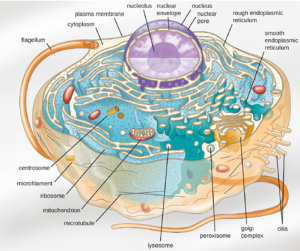
While all organelles are important for cellular function for this course the following organelles are of particular importance:
1. Nucleus: The nucleus is the largest and most prominent of a cell’s organelles. The nucleus is generally considered the control center of the cell because it stores all of the genetic instructions for manufacturing proteins. Interestingly, some cells in the body, such as muscle cells, contain more than one nucleus, which is known as multinucleated. Other cells, such as mammalian red blood cells, do not contain nuclei at all. RBCs eject their nuclei as they mature, making space for the large numbers of hemoglobin molecules that carry oxygen throughout the body. Without nuclei, the life span of RBCs is short, and so the body must produce new ones constantly.
2. Plasma membrane: The cell membrane is an extremely pliable structure composed primarily of back-to-back phospholipids (a “bilayer”).Cholesterol is also present, which contributes to the fluidity of the membrane, and there are various proteins embedded within the membrane that have a variety of functions.
3. Ribosomes: Ribosomes provide the sites where information from the DNA is used to make proteins. There are two types of ribosomes: free ribosomes, which float in the cytoplasm; and attached ribosomes, which are attached to the membranes of the endoplasmic reticulum. Attached ribosomes are also sometimes called “bound” or “fixed” ribosomes.
4. Mitochondria: A mitochondrion (plural = mitochondria) is a membranous, bean-shaped organelle that is the “energy transformer” of the cell. Mitochondria consist of an outer lipid bilayer membrane as well as an additional inner lipid bilayer membrane. The inner membrane is highly folded into winding structures with a great deal of surface area, called cristae. It is along this inner membrane that a series of proteins, enzymes, and other molecules perform the biochemical reactions of cellular respiration. These reactions convert energy stored in nutrient molecules (such as glucose) into adenosine triphosphate (ATP), which provides usable cellular energy to the cell.
5. Lysosomes: Lysosomes are small sacs bounded by a single membrane. They contain enzymes which can digest all the different types of organic molecules found inside of cells. Lysosomes perform a number of functions, including the breakdown of bacteria, viruses, and toxins brought into the cell by phagocytosis.
The nucleic acids differ in their type of pentose sugar. Deoxyribonucleic acid (DNA) is nucleotide that stores genetic information. DNA contains deoxyribose (so-called because it has one less atom of oxygen than ribose) plus one phosphate group and one nitrogen-containing base. The “choices” of base for DNA are adenine, cytosine, guanine, and thymine. Ribonucleic acid (RNA) is a ribose-containing nucleotide that helps manifest the genetic code as protein. RNA contains ribose, one phosphate group, and one nitrogen-containing base, but the “choices” of base for RNA are adenine, cytosine, guanine, and uracil.
A protein is an organic molecule composed of amino acids linked by peptide bonds. You may recall that proteins have many different functions. Some that are of particular importance for this course include:
1. Structural support: These types of proteins strengthening cells and tissues.
2. Immunological: These proteins play a role in the body’s immune response and includes antibodies and complement proteins.
3. Transport: These types of proteins help to move material. Of most import for this course are those that are found embedded in the plasma membrane and help to regulate what enters and leaves the cell.
4. Cell signaling: These types of proteins allow the cell to respond to external stimuli. They are often found in the plasma membrane and bind to factors in the extracellular environment, eliciting a response from the cell. As you will discover, these types of proteins play a large role in in regulating the immune response in animals, and facilitate taxis and communication in bacteria.
5. Catalysis: Protein enzymes are involved in nearly every biochemical process in the body. Enzymes are essential for the proper functioning of every living organism. They are able to increase the rates of chemical reactions by at least a million fold. Enzymes can synthesize, break down, or even modify molecules (Figure 2.2).
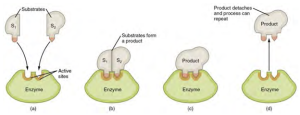
At its most simplistic, the central dogma states that DNA serves as a template for the synthesis of messenger RNA (mRNA), which then serves as a template for the synthesis of proteins. While in more recent years, scientists have discovered that there are exceptions to this basic principle, understanding the processes involved is important for understanding a number of concepts in microbiology, especially the replication of viruses.
In order for an organism to grow, develop, and maintain its health, cells must reproduce themselves by dividing to produce two new daughter cells, each with the full complement of DNA as found in the original cell. A DNA molecule is made of two strands that “complement” each other in the sense that the molecules that compose the strands fit together and bind to each other, creating a double-stranded molecule that looks much like a long, twisted ladder. Each side rail of the DNA ladder is composed of alternating sugar and phosphate groups (Figure 2.3). The two sides of the ladder are not identical, but are complementary. These two backbones are bonded to each other across pairs of protruding bases, each bonded pair forming one “rung,” or cross member. The four DNA bases are adenine (A), thymine (T), cytosine (C), and guanine (G). Because of their shape and charge, the two bases that compose a pair always bond together. Adenine always binds with thymine, and cytosine always binds with guanine. The particular sequence of bases along the DNA molecule determines the genetic code. Therefore, if the two complementary strands of DNA were pulled apart, you could infer the order of the bases in one strand from the bases in the other, complementary strand. For example, if one strand has a region with the sequence AGTGCCT, then the sequence of the complementary strand would be TCACGGA.
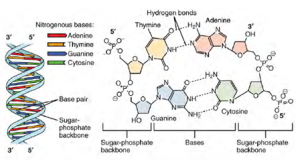
DNA replication is the copying of DNA that occurs before cell division can take place. During DNA replication, the two strands of DNA in a chromosome separate and each strand of DNA is complimentary to the other, the old DNA strands serve as templates for the newly synthesized strands. This copying is done by the enzyme DNA polymerase (Figure 2.4).
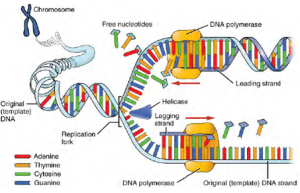
DNA is housed within the nucleus, and protein synthesis takes place in the cytoplasm, thus there must be some sort of intermediate messenger that leaves the nucleus and manages protein synthesis. This intermediate messenger is messenger RNA (mRNA), a single-stranded nucleic acid that carries a copy of the genetic code for a single gene out of the nucleus and into the cytoplasm where it is used to produce proteins.
There are several different types of RNA, each having different functions in the cell. The structure of RNA is similar to DNA with a few small exceptions. For one thing, unlike DNA, most types of RNA, including mRNA, are single-stranded and contain no complementary strand. Second, the ribose sugar in RNA contains an additional oxygen atom compared with DNA. Finally, instead of the base thymine, RNA contains the base uracil.
Gene expression begins with the process called transcription, which is the synthesis of a strand of mRNA that is complementary to the gene of interest. This process is called transcription because the mRNA is like a transcript, or copy, of the gene’s DNA code. Transcription begins in a fashion somewhat like DNA replication, in that a region of DNA unwinds and the two strands separate, however, only that small portion of the DNA will be split apart. This section of DNA serves as a template for the synthesis of RNA, which is done by an enzyme called RNA polymerase (Figure 2.5). This mRNA is processed then leaves the nucleus and into the cytoplasm, the site of protein synthesis.
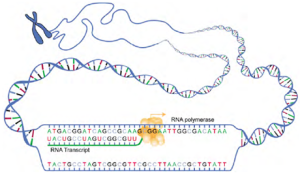
Like translating a book from one language into another, the information on a strand of mRNA must be translated into the amino acid alphabet of proteins. Translation is the process of synthesizing a chain of amino acids called a polypeptide. The process of translation is carried out by the ribosomes. Ribosomes are able to read the information contained in the sequence of nucleotides of a strand of mRNA and generate a sequence of amino acids. (Figure 2.6) Completed polypeptides then undergo further processing to generate functional proteins. Thus, a gene within the DNA molecule is transcribed into mRNA, which is then translated into a protein product (Figure 2.7)

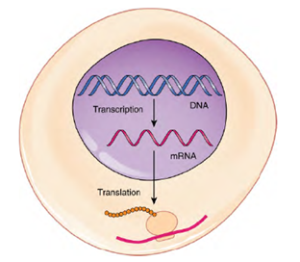
scientific principle explaining the flow of genetic information from DNA to RNA to protein
process of synthesizing RNA using the information encoded in DNA
process of protein synthesis whereby a ribosome decodes an mRNA message into a polypeptide product

